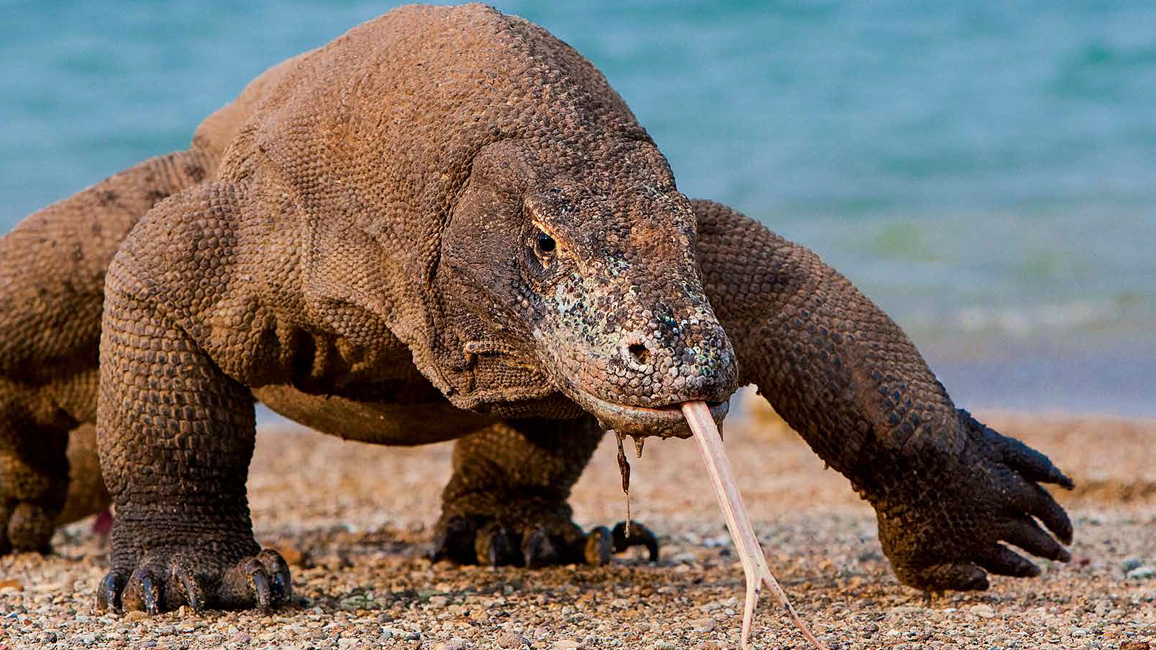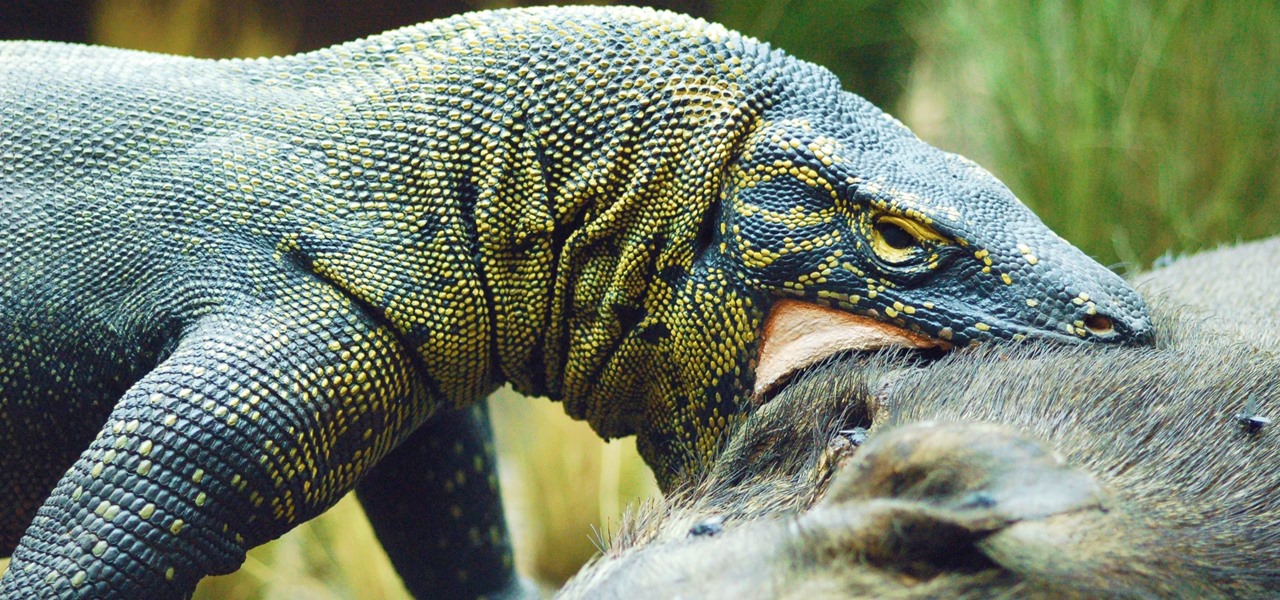Komodo dragons hunt and kill using a devastating combination of physical force and biochemical weaponry. Their attacks rely on sharp, serrated teeth that tear flesh efficiently, followed by a venomous bite that disrupts blood clotting and weakens prey. These reptiles are the largest living lizards on Earth, built with long, muscular tails, powerful limbs, and strong, flexible necks that allow sudden bursts of movement during an ambush. Their bodies are designed for dominance, endurance, and efficiency rather than speed alone.
A Komodo dragon’s tongue is long, yellow, and forked, constantly flicking in and out to sample chemical signals in the air. Adults typically display an almost uniform stone-gray coloration, broken up by thick, armor-like scales that protect them during fights and hunts. Juveniles look strikingly different, often showing brighter colors and complex patterns that help them blend into trees and vegetation during their most vulnerable years.
Their feeding anatomy is as extreme as their appearance. The muscles of the jaw and throat are exceptionally strong, allowing a Komodo dragon to swallow enormous chunks of meat with surprising speed. Several movable joints in the skull, including the intramandibular hinge, allow the lower jaw to open far wider than that of most reptiles. The stomach itself expands easily, enabling an adult to consume up to 80 percent of its own body weight in a single feeding. This ability explains historical reports of unusually heavy individuals captured after feeding. When threatened or needing to escape quickly, Komodo dragons can regurgitate the contents of their stomachs to reduce body weight and improve mobility.
Despite their size differences, males and females show few obvious external distinctions. Males tend to grow larger and bulkier, but clear visual markers separating the sexes are rare. One subtle difference exists in the arrangement of scales just in front of the cloaca, though this feature is difficult for human observers to use reliably. Researchers often struggle to determine sex without invasive methods, while the dragons themselves appear to identify one another effortlessly.
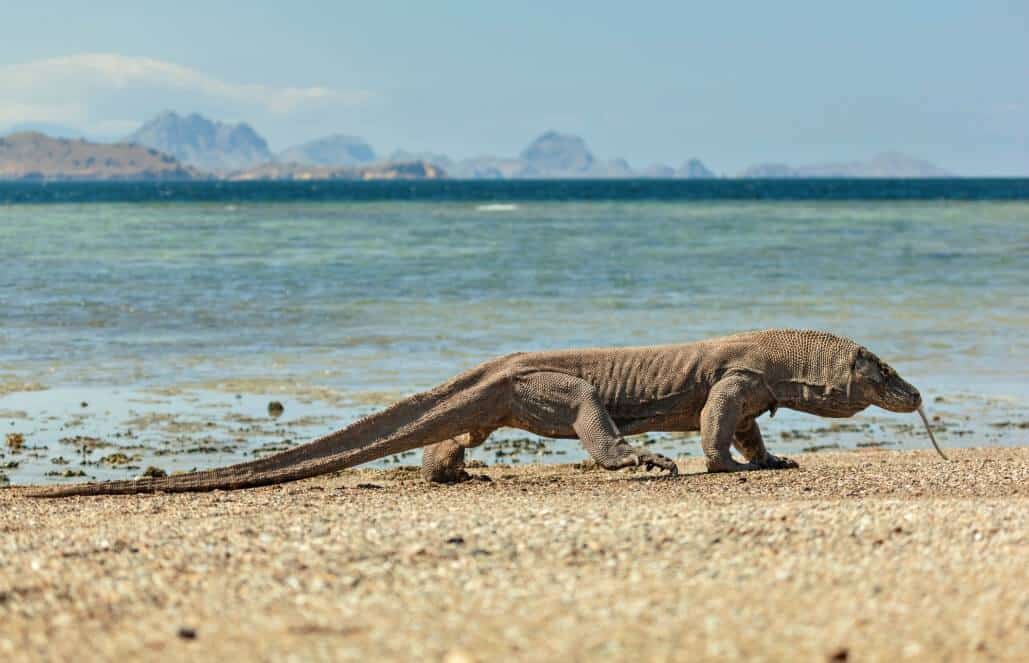
Komodo Dragon Facts: Venom, Size, and Natural Behavior
Size
The Komodo dragon holds the title of the largest living lizard species in the world. In the wild, adult individuals typically weigh around 154 pounds, or roughly 70 kilograms. Their massive build reflects a life spent dominating prey and competitors in a harsh, resource-limited environment.
Exceptional individuals can reach extraordinary dimensions. The largest verified Komodo dragon ever recorded measured 10.3 feet, or 3.13 meters, in length and weighed an astonishing 366 pounds, or 166 kilograms. Such specimens are rare, but they demonstrate the upper limits of the species’ growth potential. As a general pattern, males grow larger and heavier than females, benefiting from increased strength during competition for food and mates.
Native Habitat
Komodo dragons are found only in a small and isolated region of Indonesia, making their natural range one of the most restricted of any large predator. They inhabit several islands within the Lesser Sunda group, including Rintja, Flores, and the island of Komodo itself, which is the largest of the group at approximately 22 miles, or 35 kilometers, in length. Although they were once present on the island of Padar, Komodo dragons have not been seen there since the 1970s.
Within these islands, Komodo dragons occupy a variety of landscapes. They are most commonly associated with tropical savanna forests, where open ground and sparse vegetation favor ambush hunting. However, their range is not limited to one habitat type. These reptiles move freely from beaches and coastal lowlands to higher ridge tops, adjusting their behavior to local conditions. This adaptability allows them to exploit different prey sources and survive in environments that shift dramatically between wet and dry seasons.
Food / Eating Habits
Komodo dragons are opportunistic and highly adaptable carnivores, capable of feeding on almost any source of meat available within their territory. Their diet includes both scavenged carcasses and actively hunted animals, ranging from small rodents to massive water buffalo. This flexibility allows them to survive in environments where food availability can fluctuate dramatically throughout the year.
Young Komodo dragons begin life feeding on relatively small prey. During their early years, they rely on insects, small lizards, snakes, and birds, which they can capture while living higher in trees to avoid cannibalism by larger adults. As they grow and reach around five years of age, their diet expands significantly. At this stage, they begin targeting larger animals such as rodents, monkeys, goats, wild boars, and deer, which make up a substantial portion of their adult diet. As top-level predators, Komodo dragons sit at the apex of the food chain and are also known to cannibalize smaller members of their own species.
Although a Komodo dragon can briefly reach speeds between 10 and 13 miles per hour, its hunting strategy does not depend on long pursuits. Instead, it relies on patience, stealth, and explosive power. A dragon may remain motionless for hours along a game trail, blending into the surrounding vegetation as it waits for a deer or other suitable prey to wander within striking distance. When the moment arrives, it launches a sudden attack, delivering a powerful bite and slashing wounds.
Most hunting attempts do not result in an immediate kill. However, a successful bite introduces a lethal combination of bacteria and venom into the prey’s bloodstream. Over the course of several days, the prey weakens, succumbs to infection, blood loss, or shock, and eventually dies. Once the animal collapses, which can take up to four days, the Komodo dragon uses its extraordinary sense of smell to locate the carcass. Multiple dragons often converge on the same kill, feeding together with little hesitation.
Vision plays a supporting role in hunting. Komodo dragons can see objects up to approximately 985 feet, or 300 meters, away, and they are particularly adept at detecting movement. Their eyes, however, are less effective at distinguishing stationary objects and perform poorly in low-light conditions. Hearing is also limited, with a narrower range than that of humans, making them unable to detect very low-pitched voices or high-pitched sounds.
The most important sense used in locating food is smell. Komodo dragons rely on their long, yellow, forked tongues to sample airborne particles. Each flick of the tongue collects chemical cues from the environment, which are then transferred to the Jacobson’s organs located on the roof of the mouth. By comparing scent concentrations on each fork of the tongue, the dragon can determine not only the presence of prey, but also its direction of travel.
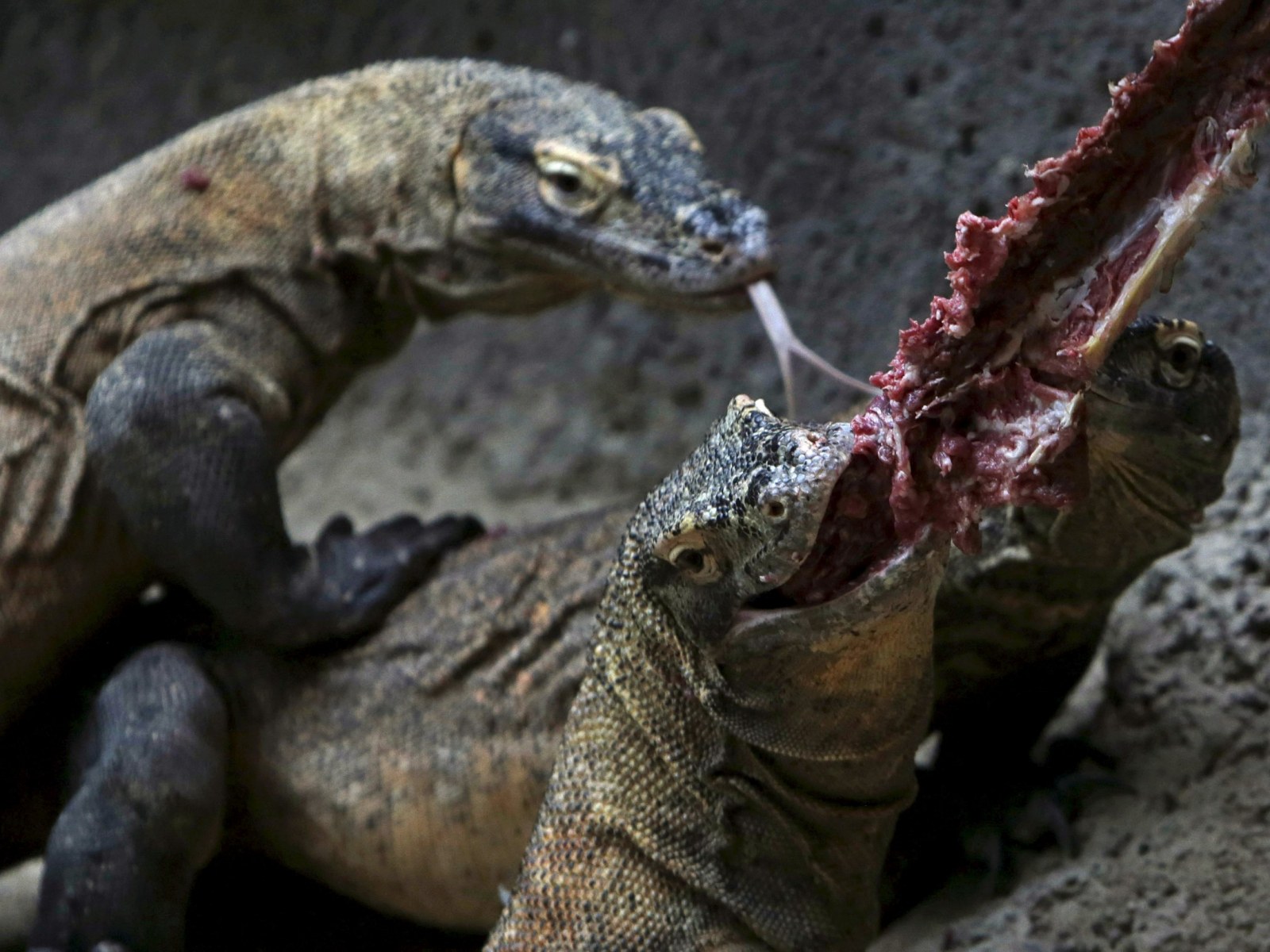
This sensory system, combined with an undulating walking motion in which the head swings from side to side, allows Komodo dragons to track food sources with remarkable accuracy. In some cases, they can detect the scent of carrion from as far as 2.5 miles, or 4 kilometers, away.
The Komodo dragon’s teeth are among its most dangerous tools. Large, curved, and sharply serrated, they slice through flesh with ease. The serrations trap bits of meat from previous meals, creating a protein-rich environment that supports the growth of bacteria. Researchers have identified more than 50 strains of bacteria in Komodo dragon saliva, including several that are highly septic. In addition to bacterial infection, scientists have confirmed the presence of venom glands in the lower jaw. This venom interferes with blood clotting, causing rapid blood loss and contributing to shock in the bitten animal.
Interestingly, while the Komodo dragon’s bite is deadly to most prey, it does not appear to have the same effect on other Komodo dragons. Individuals injured during fights or sparring show little reaction to the bacteria and venom, leading researchers to investigate the presence of natural antibodies in their blood that may provide immunity.
The mechanics of feeding are as impressive as the hunt itself. Strong throat and neck muscles allow the dragon to rapidly swallow massive chunks of meat. Flexible joints in the skull enable an unusually wide jaw opening, while the expandable stomach accommodates enormous meals. An adult can consume up to 80 percent of its own body weight in a single feeding. If danger arises, the dragon can regurgitate the contents of its stomach to reduce weight and escape more easily.
Komodo dragons are exceptionally efficient eaters. They typically consume nearly the entire carcass, leaving behind only about 12 percent of the animal. Bones, hooves, hide, and even intestines are eaten, with the latter often swung violently to remove their contents before ingestion.
In captivity, Komodo dragons are fed a controlled diet that reflects their natural preferences. At the Smithsonian’s National Zoo, individuals are fed rodents, chicks, rabbits, and occasional fish or beef carcasses to maintain their health and natural feeding behaviors.
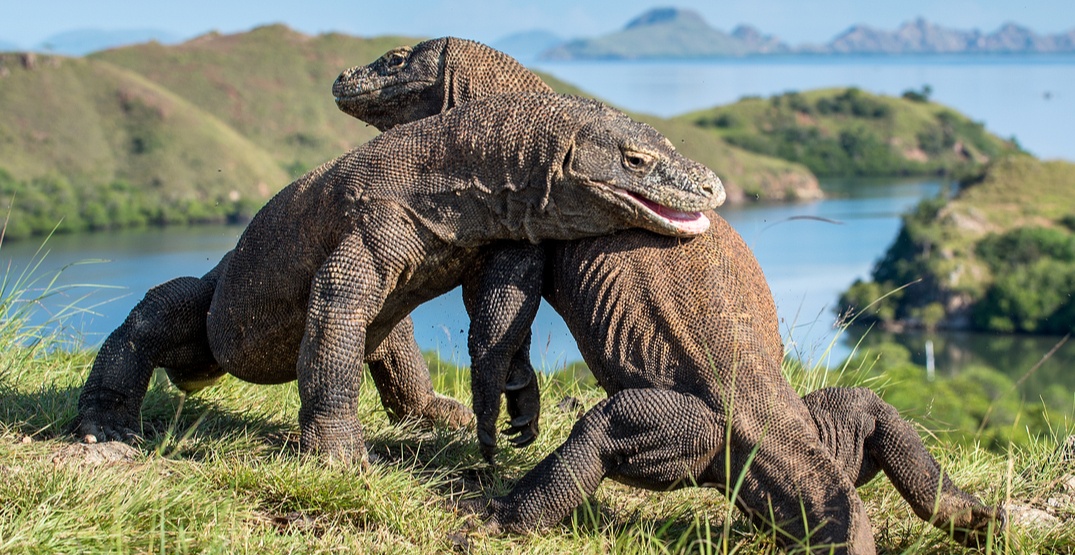
Social Structure
Komodo dragons are largely solitary animals, but their social interactions become visible when food is involved. Because adult dragons are cannibalistic, juveniles face constant danger from larger individuals. To survive, young Komodos employ unusual strategies that reduce the risk of being recognized as prey. One of the most effective methods is rolling in fecal material, which masks their natural scent and makes them less attractive to adults that instinctively avoid the smell.
In situations where multiple dragons gather around a carcass, a loose social hierarchy emerges. Larger and more dominant individuals feed first, while smaller dragons wait at the edges. Young Komodos perform appeasement behaviors to signal submission and avoid aggression. These rituals include pacing around the feeding site in a deliberate, exaggerated manner, holding the tail straight out, and swaying the body from side to side. Such displays reduce the likelihood of attack and allow juveniles to scavenge safely once dominant dragons are satiated.
Reproduction and Development
Determining the sex of a Komodo dragon is notoriously difficult, even for experienced researchers. Males and females lack obvious external differences, though a subtle variation in the arrangement of scales just in front of the cloaca can sometimes provide a clue. Mating opportunities typically arise when multiple dragons gather at a carcass, and the breeding season generally runs from May through August.
During this period, dominant males compete for access to females through ritualized combat. Using their tails as support, two males rear up on their hind legs and grapple in upright positions, attempting to overpower one another with their forelimbs. These contests can be intense, with blood frequently drawn. The defeated male either retreats from the area or remains motionless on the ground, signaling submission.
Females usually lay around 30 eggs, depositing them in shallow depressions dug into hillside slopes or within abandoned nests of megapode birds. These bird nests, made from large mounds of earth and vegetation, provide a stable environment for incubation. Egg laying may be delayed, which can help avoid the extreme heat of the dry season and may allow unfertilized eggs a second chance to develop after subsequent mating.
The eggs incubate for approximately nine months. During this time, the female may remain near the nest to offer some degree of protection, though no parental care is provided once the hatchlings emerge. Newly hatched Komodo dragons are small and vulnerable, weighing less than 3.5 ounces and measuring about 16 inches in length. Predation is a constant threat, including from other Komodo dragons.
Growth is slow but steady. By the age of five, juveniles typically weigh around 55 pounds and reach lengths of about 6.5 feet. At this stage, they begin targeting larger prey and gradually transition into the dominant predators seen in adulthood. Komodo dragons continue growing slowly throughout their lives.
Diet
As the dominant predators on the islands they inhabit, Komodo dragons consume a wide range of prey. Their diet includes carrion, deer, pigs, smaller Komodo dragons, and even large water buffalo. When hunting live prey, they rely heavily on camouflage and patience, remaining motionless until an opportunity arises. Once a suitable animal comes within reach, the dragon lunges forward, using its powerful claws and serrated teeth to inflict devastating wounds.
This ambush-based strategy allows Komodo dragons to bring down animals far larger than themselves, conserving energy while maximizing the effectiveness of each attack.
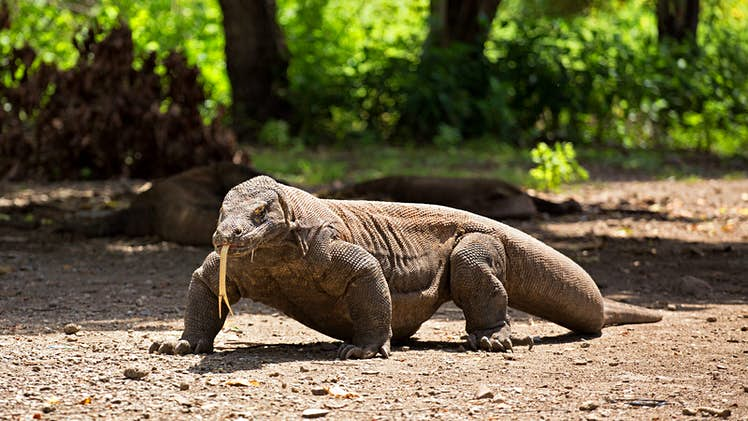
Threats to survival
Despite their dominance as predators, Komodo dragons face several threats that endanger their long-term survival. One unusual challenge stems from their ability to reproduce asexually through parthenogenesis. While this allows isolated females to produce offspring, the process results exclusively in male hatchlings. Over time, this imbalance can reduce genetic diversity and increase inbreeding within fragmented populations.
Komodo dragons also tend to remain within relatively small home ranges, rarely dispersing far from their birthplace. This reluctance to migrate limits genetic exchange between populations and exacerbates the effects of habitat fragmentation as numbers decline.
Human activity presents additional pressures. Habitat destruction through burning, poaching of both Komodo dragons and their prey, and disruption caused by human presence all contribute to population stress. Tourism has had mixed effects. While visitors sometimes interfere with feeding and mating behaviors, tourism also provides economic incentives for local communities to support conservation. In response to growing concerns, Indonesian authorities have even considered temporary closures of Komodo Island to reduce human impact.
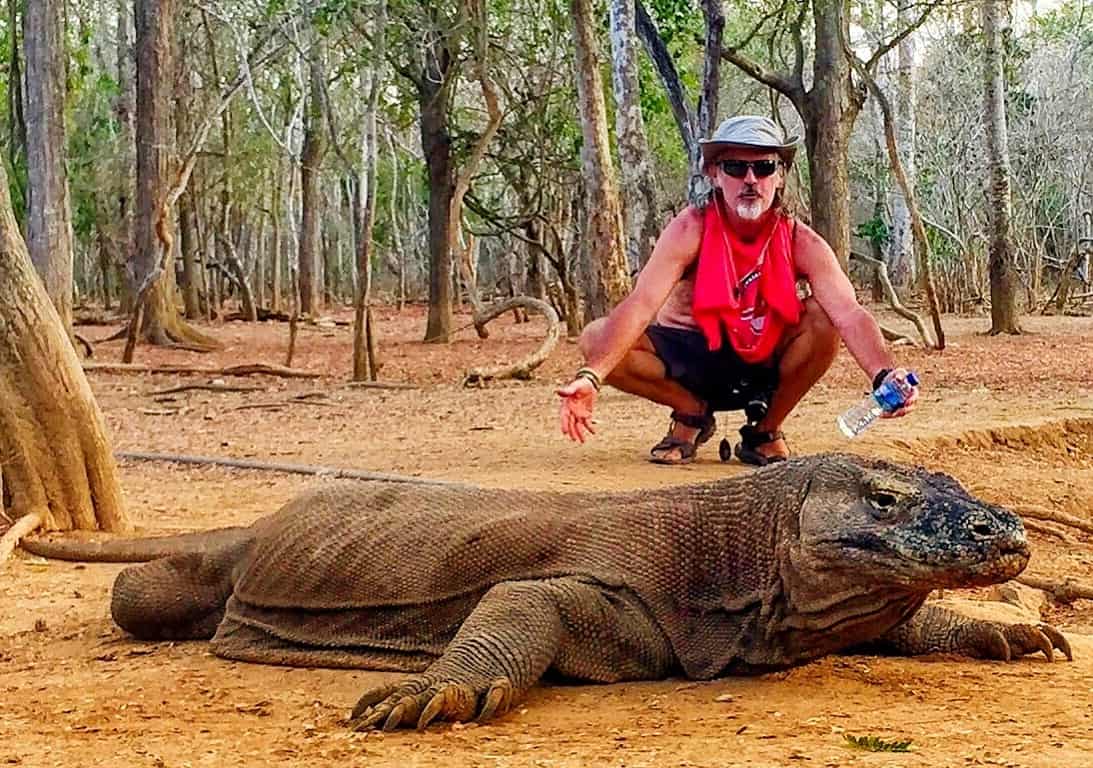
Conservation
Recognizing the ecological and cultural importance of the Komodo dragon, Indonesia established Komodo National Park in 1980 to protect both the species and its habitat. Covering roughly 700 square miles, the park encompasses not only terrestrial environments but also a rich marine ecosystem. In addition to Komodo dragons, the area supports species such as the orange-footed scrub fowl, Timor deer, whales, dolphins, sea turtles, sharks, manta rays, corals, sponges, and more than a thousand species of fish.
Komodo National Park has since been designated a UNESCO World Heritage site, reflecting its global significance. Conservation efforts within the park include anti-poaching patrols, habitat protection, and education programs aimed at increasing awareness among local communities. By balancing conservation with sustainable tourism, these initiatives aim to ensure that Komodo dragons continue to survive in the wild while maintaining the ecological integrity of their island home.

